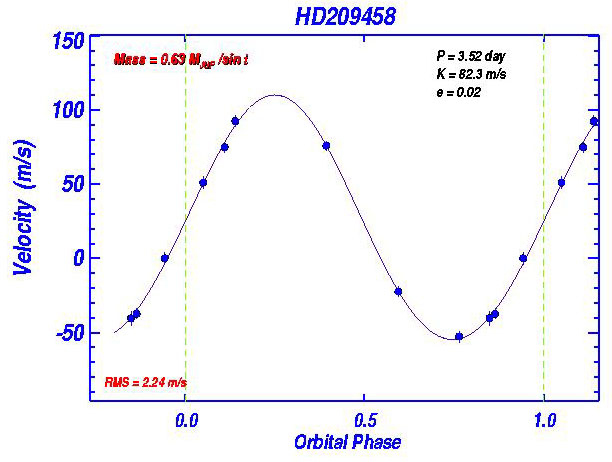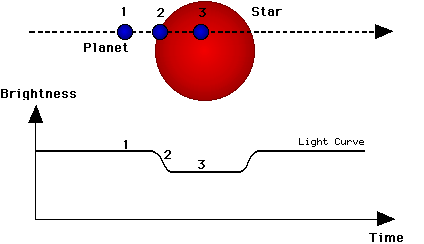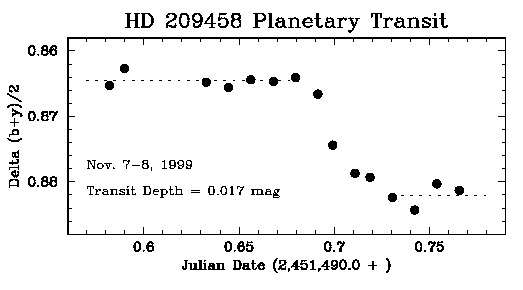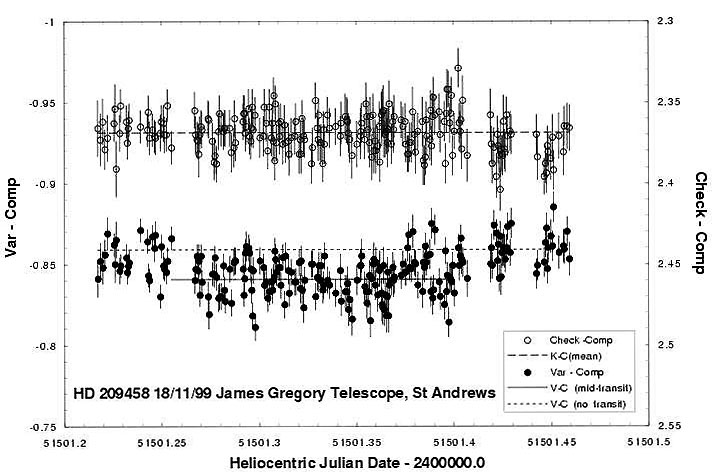 HD 209458 (F8-G0V
színképtípus)
HD 209458 (F8-G0V
színképtípus) HD 209458 (F8-G0V
színképtípus)
HD 209458 (F8-G0V
színképtípus)magyar nyelvű ismertető az [origo]-ban
IAU Cirkulárok hírei:
No. 7307, 1999 November 12 Daniel W. E. Green
Central Bureau for Astronomical Telegrams INTERNATIONAL ASTRONOMICAL
UNION
URL http://cfa-www.harvard.edu/iau/cbat.html
HD 209458
G. W. Henry, Tennessee State University; G. Marcy, University of California
at Berkeley; R. P. Butler, Department of Terrestrial Magnetism, Carnegie
Institution of Washington; and S. S. Vogt, Lick Observatory, report: "The
G0 V star HD 209458 = BD +18 4917 (R.A. = 22h03m10s.78, Decl. = +18o53'03".5,
equinox 2000.0; V = 7.65) exhibits sinusoidal velocity variations with
a semiamplitude of 81 m/s, indicating the presence of a companion with
M sin i = 0.63 Jupiter mass and an orbital period of 3.523 days. Photometry
reveals a transit ingress on Nov. 8.20 UT with a depth of 0.017 mag,
consistent with the transit time predicted from the velocities. Further
measurements of transits and velocities would be valuable.
The next three predicted times of ingress occur at Nov. 15.263, 18.787,
and 22.311 (all times uncertain by 1 hr). If correct, the inferred mass
is 0.63 that of Jupiter, and radius 1.6 that of Jupiter, implying a density
of 0.21 g/cm^3. HD 209458 resides at a distance of 47 pc, with rotational
v sin i = 3 km/s, and is chromospherically inactive, with an estimated
age of 4.5 Gyr."
Circular No. 7314, 1999 November 22
R. Rebolo, M. R. Zapatero Osorio, H. J. Deeg, and J. Licandro, Instituto de
Astrofisica de Canarias; and J. Marti, University of Jaen, report: "CCD photometry
of the star HD 209458 obtained at the 1.5-m Spanish Telescope at Calar Alto
reveals a transit egress of the planet reported on IAUC 7307, with a depth of
0.023 +/- 0.005 mag, on Nov. 18.87 UT. Ingress started before observations,
but assuming an orbital period of 3.523 days, the transit lasts 3.0 +/- 0.1
hr. Best fits give an orbital inclination of 87.0 +/- 0.5 deg and a planet radius
1.34 +/- 0.07 that of Jupiter." R. A. Street, T. A. Lister, A. Cameron, and
K. Horne, St. Andrews University, report that 640-nm narrowband CCD photometry
of HD 209458 with the 0.9-m Gregory telescope in St. Andrews confirms that a
planetary transit with depth of 0.019 +/- 0.003 mag occurred from Nov. 18.760
+/- 0.021 to 18.903 +/- 0.031 UT. Z. Ioannou, C. Hellier, R. D. Jeffries, and
T. Naylor, Keele University, report that V-band photometry with the 0.6-m telescope
at Keele Observatory are consistent with an egress as reported above, but the
increasing airmass makes the data from this time onwards unreliable. For further
details, see http://star-www.st-and.ac.uk/~ras11/indexPS.html."
Circular No. 7315, 1999 November 22
In response to a request from the Central Bureau, D. W. Latham, Harvard-Smithsonian
Center for Astrophysics, communicates on behalf also of D. Charbonneau,
T. M. Brown, M. Mayor, and T. Mazeh: "We have prepared an updated ephemeris
for the transits of HD 209458. This ephemeris is based on 150 velocity
observations dating back to Aug. 1997 (made with HIRES on Keck I, as part
of the G Dwarf Planet Search under NASA time, with ELODIE on the 1.93-m
telescope at Observatoire de Haute Provence, and with CORALIE on the
new Swiss 1.2-m telescope at La Silla; a paper describing the spectroscopic
results is in preparation) and on two complete transit observations obtained
on 1999 Sept. 8 and 15 (made by Charbonneau and Brown with the STARE instrument
at the High Altitude Observatory, National Center for Atmospheric Research,
Boulder, and reported in a paper submitted to Ap.J. Lett. by Charbonneau,
Brown, Latham, and Mayor). G. Torres has carried out a simultaneous solution
of the radial velocities and the transit observations and provided the
following orbital period and epoch of transit center: P = 3.52433 +/- 0.00027
days, T_c = 2451430.8238 +/- 0.0033 (HJD). Predictions for the center of
the transits through the end of Dec. 1999 are: HJD 2451508.3590 +/- 0.0080,
2451511.8833 +/- 0.0083, 2451515.4077 +/- 0.0086, 2451518.9320 +/-
0.0089, 2451522.4563 +/- 0.0091, 2451525.9806 +/- 0.0094, 2451529.5050
+/- 0.0097, 2451533.0293 +/- 0.010, 2451536.554 +/- 0.010, 2451540.078
+/- 0.011, 2451543.602 +/- 0.011. Observers should plan to monitor the
star for at least 2 hr before and after these times of transit center.
Our identification of HD 209458 as a prime target for transit observations
was made possible by the
many contributions of the G Dwarf Planet Search, ELODIE, and CORALIE
teams: J. L. Beuzit, M. Burnet, G. A. Drukier, D. Naef, F. Pepe, C. Perrier,
D. Queloz, N. Santos, J. P. Sivan, G. Torres, S. Udry, and S. Zucker."
Circular No. 7317, 1999 November 24
G. Gonzalez, University of Washington, writes that he obtained differential
CCD photometry of HD 209458 during Nov. 22.07-22.35 UT, using the the Manastash
Ridge Observatory 0.76-m telescope, with C. Laws and M. Braunstein. An
8-nm-side filter centered at 673 nm was used to obtain images every about
3 min. They detect a dimming of HD 209458 starting at Nov. 22.28 +/- 0.015
day, but they did not observe long enough to see last contact, due to the
low altitude of the star. They estimate that the dimming amounted to about
0.028 mag (using two comparison stars that were each about 4
mag fainter than HD 209458).
Circular No. 7323, 1999 December 1
E. Poretti, Brera Astronomical Observatory, writes: "Forty-six V photoelectric
measurements of HD 209458 obtained with the Merate 0.5-m telescope show
that a transit (depth 0.016 +/- 0.002 mag) started at Nov. 25.815 UT. Observations
began at Nov. 25.74, but stopped at Nov. 25.91 due to large airmass, before
egress. Analysis of B photometry is in progress."
Independent reports have been received from S. Soderhjelm, Lund Observatory;
and from N. Robichon and F. Arenou, DASGAL, Observatoire de Paris, Meudon,
of the existence of five HD 209458 transits in 89 separate Hipparcos photometric
measurements obtained between 1991 Apr. 17 and Nov. 4. Robichon and Arenou
report that the mean depth of the transits is 0.025 +/- 0.004 magnitude
in the Hipparcos H_p band, corresponding to a relative depth in the flux
of 2.3 +/- 0.4 percent (results submitted to A.Ap.). Using the epoch T_c
of Charbonneau et al. (submitted to Ap.J. Lett.; see also IAUC 7315),
periods of 3.524738 +/- 0.000015 (Robichon and Arenou) and 3.52473
+/- 0.00005 (Soderhjelm) days have been derived. Soderhjelm's details will
appear on IBVS 4816.


| Paraméter | számolt érték |
| Keringési periódus | 3.528 nap |
| Radiális sebesség félamplitudó (K) | 81 +/- 3 m/s |
| Pálya félnagytengely | 0.045 Cs.E. |
| Excentricitás | 0.01 +/- 0.03 |
| M sin i (M Jup) | 0.63 |
A Nap és a HD209458 összehasonlítása:
| Paraméter | Nap | HD209458 | Forrás |
| T (Kelvin) | 5780 | 6000 | . |
| Mv | 4.79 | 4.29 | Hipparcos. |
| Log grav (cgs) | 4.45 | 4.31 | Blackwell et al, 1994, A&A, 282, 899 |
| Színképtípus | G2V | F8V | SIMBAD |
| R'hk | -4.937 | -4.93 | Keck/HIRES H&K Line |
| P rot (nap) | 25.4 | ~30 +- 10 d | from chromospheric K-line (Noyes et al.) |
| Vsin i (km/s) | 1.8 | 3 | Keck/HIRES Spectrum |
| [Fe/H] | 0.00 | Unknown? | - |


A csillag
fényességének változása a bolygó előtte
való átvonulása miatt.

November 18.: A csillag fényességének változása
a bolygó előtte való átvonulása miatt.